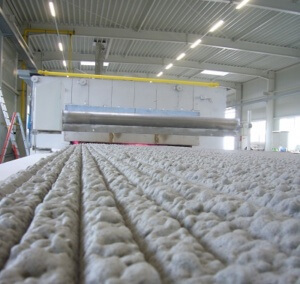 Ryan Stojic, General Manager at Mike Wye & Associates Ltd. explains why…
Ryan Stojic, General Manager at Mike Wye & Associates Ltd. explains why…
In our ever growing world, choosing sustainable materials in construction is often a conscious decision or implemented condition which is made solely to minimise the impact on our environment.
But look a little further and you will see that many sustainable construction materials offer significant benefits thanks to their natural properties. These properties can play a major part in the preservation of our heritage, offer function and practicality, and can even offer cost savings verses conventional construction methods.
GEOCELL foam glass gravel is one such material.
So what is foam glass gravel?
Foam glass gravel (or aggregate) has been used widely across mainland Europe for a couple of decades but is a relatively new construction material to the UK market. It is a lightweight material made from 100% recycled glass.
90% of glass used in the production of foam glass comes from bottles and other coloured glass. The other 10% is clean, sheet glass (mainly from windows). This combination provides the optimum blend when foaming due to sheet glass being significantly more reactive than coloured glass – which contain oxides to colour them, such as the glass used for our green wine bottles.
The crude glass starts out with all the impurities you would expect to see in our own recycling tubs, such as ceramics, plastics and paper. The majority of these are removed by heating and separating before the next stage of production can begin.
The remaining glass and small percentage of impurities (less than 1%) is then ground to a very fine powder resembling a talc.
This glass powder is then mixed with a natural foaming agent and water glass before heating. Many organic and inorganic foaming agents can be used which ultimately affects the ability of the mixture to foam, the colour and the compressive strength. For this reason, the colour and properties of foam glass can vary between manufacturers.
The foam glass ‘cake’ mixture then passes on a conveyor belt through a series of chambers which apply regulated temperature increases before a final chamber which cools the finished product. The cooled product begins to fracture after passing through the cooling chamber and finally breaks off into the foam glass aggregate and end product. The resulting sustainable product is a lightweight material which resembles pumice.
Where is foam glass gravel used, and why?
GEOCELL foam glass is exceptionally stable, durable, safe to handle and more importantly an environmentally-friendly building material. This inorganic material combines all the material properties that are required in building construction:
Insulation – no extra frost protection is necessary, and the complete omission of other floor sub-components is possible in thermal-bridge-free construction (design value 0.08 W/mK).
Load-bearing – the cellular structure and extremely high specific surface of foam glass facilitate an exceptional pressure load (compressive strength design value of 275 kN/m²).
Stabilizing -the improvement of the load-bearing capacity of unstable terrain can replace measures such as pillar foundations and consolidation fills.
Free draining and non-capillary – the closed-cell surface of foam glass prevents soil moisture from entering the structure.
Inert – it meets the highest standards for inert building materials. Leaching tests did not show any resulting adverse environmental effects whatsoever.
Lightweight – the bulk weight of GEOCELL foam glass is only 150 kg/m³. Standard hardcore weighs approximately 20 times more.
Fire resistant – non-combustible Class A1 with a melting point above 700°C.
These beneficial properties explain why foam glass is being used increasingly in the UK for the renovation of historic buildings, in new build projects, and across various civil engineering applications.
Because of the light weight property of foam glass it has been an obvious choice fill material for the renovation of vaults. Significantly less stress is created compared to filling with heavier hardcore, insulation is improved, and its use also results in less additional humidity compared to denser materials.
GEOCELL foam glass is extremely light and allows for dry and extremely simple installation.
Another increasingly popular application of foam glass is in limecrete floors. These functional floor systems are designed to offer a capillary break in traditional buildings in order to reduce dampness which can be caused by restrictive materials, such as damp proof membranes. Foam glass has become a firm favourite for the non-capillary sub-base in limecrete floors due to the ease of application, and the improved insulation values it offers over alternate sub-bases (which make it ideal for floors where underfloor heating is to be installed). Furthermore, the suppliers of GEOCELL foam glass in the UK are able to provide a registered system by Local Authority Building Control (LABC) which means the system is pre-approved and should not result in conflict or objection from your local Building Control department.
Much like limecrete floor systems in traditional buildings, foam glass can be used below the floor slab in new buildings. The benefits of using a sustainable insulation in this manner is to create a structure without thermal bridges, to simplify the specification compared to conventional methods, and reduce labour and material costs. Because foam glass is an exterior insulation, heat cannot dissipate. Therefore, water does not condense and, as a consequence, there is no mould formation.
Foam glass is a light weight fill material for road construction and bridges. It reduces the overall weight of roads in poor soil conditions, thus reducing maintenance costs. Examples of the use of foam glass in other civil engineering applications include: drainage beds, dam construction, as lightweight and free draining backfill for retaining structures, and in multi-storey buildings.
Due to its unique properties, GEOCELL foam glass is also offers excellent suitability for the insulation of district heating pipes and underground tanks such as water storage tanks or biogas plants. The use of this lightweight material results in a low load on pipes, reducing the need for large trench depth to insulate against freezing temperatures.
The perfect choice for green roofs, foam glass interlocks itself, do not roll and thus can be applied to inclined surfaces up to 15°. Due to the high friction angle, modelling of embankments up to 45° presents no problem. Combined with the lightness of the material, foam glass has very few limitations for creative landscape architects and offers optimum conditions for the landscaper.
The perfect filtration characteristics, coupled with the low weight and the excellent thermal insulation properties make foam glass gravel the perfect choice as a drainage layer for sports pitches. Excellent longitudinal and transverse drainage allows for a faster use of the sports ground after heavy rain fall, whilst the high compressive strength stabilizes the soil.
The UK glass industry has the ability to recycle millions of tonnes of glass each year. Glass can also be recycled indefinitely without compromising quality. Using virgin materials in construction can only be sustained for a limited period and construction companies now need to show compliance in reducing CO2 emissions for all new buildings.
The UK’s architects, engineers, designers, landscapers and contractors are still learning about the benefits and application possibilities for replacing elements of more familiar, conventional specifications. Foam glass use is growing steadily and the expectation is that the growth trend will continue over the next few years.
A versatile material proving to be a sustainable replacement for conventional materials – foam glass is both economical and environmentally sound.
GEOCELL Foam Glass is available in the UK from Mike Wye & Associates Ltd www.mikewye.co.uk , Eden Lime Mortar www.eden-lime-mortar.co.uk , and from Linham Construction in Ireland www.linham.ie

